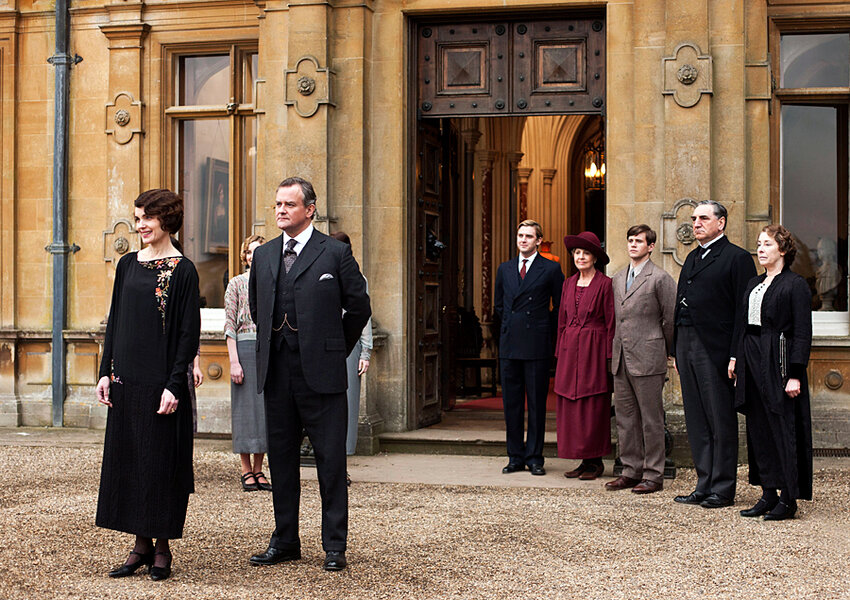Dressing Downton: Dandies revive Scotland's tweed industry
Loading...
| London
Dressed in tweed caps, waistcoats and breeches – with thick knee-length socks and brown brogues – the young men posing outside a Palladian mansion look as if they just came from the set of "Downton Abbey," the British TV costume drama.
In fact, they are models advertising outfits designed to be worn without irony in the autumn/winter of 2014 and one of the attractions at the London Menswear Fashion Week that ended Jan. 8.
Tweed – until recently associated with the hunting, shooting, and fishing set of the countryside – is fast becoming a coveted fashion among young urbanites, and not just in Britain. The reason for the uptick is partly down to the popularity of the World War I-era drama "Downton Abbey," which airs on PBS.
This month Harris Tweed Hebrides – the largest of three mills that produce the best-known version of the distinctive fabric – reported that sales had risen by a quarter in 2013 and looked set to surge in 2014.
Other mills, as well as the handful of small, independent producers of Harris Tweed, say they have seen similar revival in sales of the cloth. To earn the brand name, the fabric must be made from virgin wool and spun, woven, and finished on the islands of Harris or Lewis in Scotland's Outer Hebrides.
“Oh, it's having a wonderful revival at the moment,” says Donald John Mackay, who has woven tweed for nearly 50 years in a hut next to his house on the isle of Harris.
He was given a hint of Harris Tweed's modern potential a decade ago when Nike ordered hundreds of meters from his company, Luskentyre Harris Tweed, for use in a sneaker. This wasn’t enough to turn around decades of decline that began in the fashion-obsessed 1960s. But fashion tends to go in cycles; today’s has-been is tomorrow’s must-have item.
Mr. Mackay says the pickup in demand for the fabric is palpable. Young people from the islands are training as weavers, and mills are investing in new looms.
“It has always gone in cycles and circles, but this is certainly a good one,” he says. “It's a way of life for us – it is all we can do.”
Country gentry
“Tweedy,” according to the Oxford English Dictionary, is “of a robust traditional or rural character (by association with the country gentry who traditionally wear tweeds).”
That definition might soon be obsolete as tweed is increasingly favored by luxury fashion designers such as Chanel and Alexander McQueen. While tweed is being used for more edgy items, from biker jackets to skinny pants, the traditional designs are still the most fashionable.
Tony O'Connor, head of menswear design at Marks and Spencer, which uses Harris Tweed in many of its tailored outfits, says it is particularly popular among customers shopping for formalwear.
“Harris Tweed has a distinctive and confident style, that is fast becoming a wardrobe staple for men season after season,” he says.
That tweed is still being used to create timeless designs may be due to in part to "Downton Abbey," with its colorful cast of countesses, cooks and kitchen maids and an acclaimed line in period costume.
Like many recent television dramas, it has had an obvious influence on fashion, with shoots in glossy magazines dedicated to the “Downton look.” As it has become more popular, tweed is also being used to add cache to products from handbags to cushions.
Harris Tweed manufacturers hope this exposure will translate into rising sales in North America, which in recent years had been replaced by Japan as Harris Tweed's biggest overseas market.
The first episode of the fourth series of "Downton Abbey" drew a record audience in the US, with 10.2 million viewers, according to Nielsen Fast National data. Broadcaster PBS has said it's the highest-rated drama season première in the network's history.
Making Britain look fashionable
Margaret Macleod, brand development director of Harris Tweed Hebrides, which directly employs 80 people, says she expects demand in the US to grow this year, in part due to the tweeds paraded in the drama.
“It has helped make that British look very fashionable”, she says. “People want to hark back to that era and the beautiful clothes that people wore.”
Louise Crewe, a professor of human geography at the University of Nottingham who has done research on the tweed revival, says it can also be explained as a reaction against cheap, disposable fashion.
“Consumers are increasingly interested in spending their money on investment pieces that will last instead of lots of cheap fashion that does not,” she says. “They are beginning to realize that cheap is not (good) value.”
The latest revival of Harris Tweed echoes a broader story of high-end manufacturing in Britain. A century ago, the nation was known as the “workshop of the world,” a hotbed of innovation and production, from the ceramics of Staffordshire to the hosiery factories of the Midlands.
In the last century, Britain's dominance has been eroded by competition from the US, Germany, and the low-cost economies of emerging markets. China is now the workshop of the world.
In recent years, British manufacturing has staged a modest comeback with the "Made in Britain" stamp finding its old cache. High-end manufacturing tends to be small-scale, however, as the weavers of Harris and Lewis are well aware.
“People appreciate quality, made in the traditional, small-scale way,” says Mackay. “That's why they buy it.”







